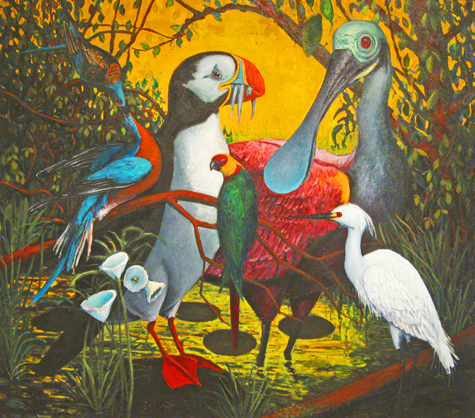
ON THE BRINK “Lost,” by Ed Smith. |
Showing the work of four bleakly conceptual visual artists in bold, animalistic explorations, Whitney Art Works's "Kingdom" is a weird dominion indeed. As if strengthening the analogy of the contemporary gallery as the zoo of the urbane, the animals contained within are separated by the framework of their pens. Andy Rosen's fantasy sculptures, Lisa Pixley's cotton prints, and Ed Smith's (oil) and Justin Richel's (gouache) canvases function like the structural differences of the estuaries, cages, and vivaria of real life menageries. Liberationists take note, however: these animals are depicted, for better or worse, in various states and strategies of escape.
Can't say I know enough about birds to certify that all of Ed Smith's subjects are real, but he certainly did his homework in recreating the beautiful purple-breasted spoonbill (not an official name, by the way). This enormous creature, one of many found in Smith's fieldbook, is a central figure in the brilliant and rapturous "Lost," where five types of birds cluster in the clearing of a swamp thicket. While all Smith's subjects are feathered friends, his birds always seem to be far from home — driven, somehow, to atypical behavior and marginal habitat. Ironic and tropical, each scenario he creates strikes a hashmark along the ethical yardstick of ecological disaster. In "The Long March," a dazzling array of birds form a sort of mechanized artillery on a hardwood domestic floor. "Flotilla" depicts a duck navigating a serene pool of water, burdened, on its back, by a great stack of other suddenly flightless species. "Lost" captures the birds on the anxious brink of mechanization, the unthinkable moment whereupon five gorgeous species from disparate climes rally in private. The vibrant yellow on the collar of a foreground parrot is monstrously echoed in the distant sky — a color no sky should get. Where much of Smith's work addresses the urgency of calamity through comical, peripheral circumstance, "Lost" siphons the symbology of exotic beauty into a biohazardous flask.
At times, the artistic dialogue between Pixley and Smith is so strong, it makes you wish John James Audubon were available to moderate. Where Smith's birds in supernaturalist environments demand an external, almost material lens, Pixley's work probes the form and function of the corpus. In "Birdie Bon Bons," three feathery stumps appear as well-packaged fetishes. The gray-brown tufts are stippled at the edges with a reddish-yellow, like the discolorations of dismemberment or disease. Where Smith's style is unmistakable, hers is amorphous, relational. "Pheasant 2," "Porcupine," and "Pheasant 1" offer a more articulate triptych to the "Bon Bons." Prints on cotton fabric, the "Pheasants" experiment with asymmetrical 3D patterns and textural info, like patchwork poultry. Though less striking, the talismanic canvasses in the "Lace Monster" series — where diaphanous dragons emerge and recede in oil and acrylic webs — Pixley's "Hound" and "Axe" are nevertheless memorable pieces. Rendered in profile, and as if antiquated, these latter two are ornate and complimentary prints. A black dog caught at the completion of his leap wears a bright red-orange collar. His body has a marbled, almost hieroglyphic gloss, as of shatterable pottery. "Axe" is inanimate, its long wooden handle sturdying a head with a strange paisley finish.